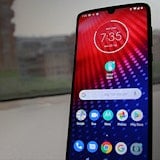 The Motorola RAZR is basically the European version of Motora's new DROID RAZR handset. It's a high end Android 2.3.5 device that takes a slightly different approach to physical design that some of the handsets we’ve previously seen from Motorola. Its sharp edges with just slightly contoured corners make for a more intriguing first impression than a device like the Motorola Atrix, but where the RAZR truly sets itself aesthetically apart is with its profile.
The Motorola RAZR is basically the European version of Motora's new DROID RAZR handset. It's a high end Android 2.3.5 device that takes a slightly different approach to physical design that some of the handsets we’ve previously seen from Motorola. Its sharp edges with just slightly contoured corners make for a more intriguing first impression than a device like the Motorola Atrix, but where the RAZR truly sets itself aesthetically apart is with its profile.
Physical design of the Motorola RAZR
The Motorola RAZR lives up to Motorola’s iconic RAZR name, taking the title of ‘thinnest smartphone outside of Japan or South Korea’ with an impressive 7.1mm profile. That little spec knocks out the previous title holder, the Samsung Galaxy S II, with its 8.5mm profile.
Around the top of the RAZR where the camera sits the profile does increase to around 8.9mm, but we found the overall reduced width allowed for the RAZR to sit in the same pocket as a wallet, without actually adding to any discomfort. That being said the RAZR was actually less noticeable when kept in the same pocket as something like a wallet than when left by itself. On its own the width and defined flat form-factor of the RAZR provided us with a constant reminder of its presence every time we took a step; something to consider for folks with small pockets.
In order to obtain this incredible thinness Motorola has made the RAZR somewhat wider than the average 4.3 inch smartphone. The extra width is definitely noticeable in the hand and is perhaps a bit less comfortable to hold than its competitors, especially when combined with the lack of surface area around the sides. It’s not a particularly huge issue, but it definitely took a bit of getting used to.
The rear plate of the RAZR is quite attractive. It’s a rubberized material with an interesting pattern that switches between grey and ash-grey. Unfortunately, due to the width of the phone, we didn’t actually find that this feature increased the grip. The phone tended to sit between our thumb and fingers, without actually resting its grippy back against the palm.
 Hardware and Speed
Hardware and Speed
The Motorola RAZR definitely doesn’t sacrifice on the hardware front to get that stylish profile. It sports a dual-core 1.2GHz processor, 1GB of RAM, 16GB of storage and that standard MicroSD slot for a further 32GB of memory if you need the extra space.
Basically these specs are either the same, better or at least similar to every other top-end phone that’s currently available on the market. The dual-core CPU is fast, the 1GB of RAM allows for some seriously smooth operating and the 16GB of internal space means that you can store plenty of media, without having to worry about whether or not you need a MicroSD upgrade the day you get the device.
One particular thing we noticed that the Motorola RAZR didn’t have when compared to a lot of other dual-core handsets is heating issues. To clarify: we had none heating issues with the RAZR that we experienced with the Galaxy S II or the Motorola Atrix. The device remained a constant, comfy temperature the entire time it was in use, not matter what we threw at it.
Battery life was standard. We got a full day’s use out of the RAZR at medium-to-heavy use with the default brightness settings. Upping the brightness to max did cause a few close calls, but we find that too often be the case with modern phones and we’re not going to mark the RAZR down for that.
 Display and UI
Display and UI
The display on the Motorola RAZR is absolutely fantastic. The 4.3 inch 540 x 960 Super AMOLED display provided bright colors, dark blacks and crisp images. Oddly enough, despite it not being a Super AMOLED Plus display, the RAZR actually outdid the Samsung Galaxy S II in terms of both color vibrancy and the deepness of its blacks. This was a pleasant surprise, as we expect a good display from this device, but were still unprepared as to the level of its quality.
The higher pixel count combined with the Super AMOLED screen also greatly improved upon the video media experience that we’d seen on some other devices. The coming together of high resolution and bright colors made for a great experience, although on the brightest setting video did tend to chew battery a bit more than we’re used to seeing. We suggest toning the brightness down a little if you’re a media junkie. You’ll still get a great experience, but won’t find yourself looking for an outlet by the end of the movie.
The Motorola user interface (UI) runs smoothly. It’s very similar in layout and functionality to HTC’s Sense and Samsung’s Touchwiz 4.0 found on the Galaxy S II, but rather than copying it more feels like this is just becoming the standard layout for Android devices. We don’t have a problem with handsets on the same operating system (OS) having similar user UIs, as it allows for a more fluid feel across the whole face of Android.
But getting back to functionality, we found the UI on the Motorola RAZR to be fast, smooth and efficient. The vibrant colors of the Super AMOLED display definitely enhanced the experience and the deep blacks gave the Apps Menu a well-polished feel. We also liked that the Apps Menu could also be arrange in order of a-z, frequency of use or most recently used.
We would have preferred to see videos and pictures kept in separate places, rather than just thrown in the gallery together, but that’s more of a subjective issue and some users might even find it preferable to a segregated approach.
The lock screen was also well designed, offering the ability to jump straight in to camera mode. The camera application launched relatively quickly, which means users should be able to catch those fleeting photo-ops with a little more regularity. We would have also liked to see some messaging and missed call options on the lock screen, but unfortunately that wasn't an option. There was a toggle for switching the phone between silent and regular modes, which was at times useful, but not quite as useful as jumping straight in to whatever notifications require your immediate attention.
 Messaging, Browsing and Phone Calls on the Motorola RAZR
Messaging, Browsing and Phone Calls on the Motorola RAZR
The on-screen keyboard of the RAZR was pretty good. It managed to keep up with our speedy fingers, but we found that we tended to misspell words with more frequency than on other devices and couldn’t really figure out why. It could have been a layout issue, or that the touch commands weren’t quite sensitive enough. Either way it was still a solid typing experience.
Swype is also available straight out of the box which is a huge bonus for Swype users. If you haven’t ever tried using Swype we definitely suggest you at least give it a go. It isn’t everyone’s cup of tea, but it’s pretty handy for when you’re on the move and can only type with one hand.
Of course messaging and emails are a breeze due to the combination of the fast keyboard and Swype support. We had no issues with textual communication.
Browsing was also easy, partly due to the keyboard and partly to the great display. Web pages were bright and easy to read. We did have that issue that pops up on some Android devices when switching in between portrait and landscape modes. Some of us in the office like to search for our articles in portrait and then switch to landscape when it’s time to read. Unfortunately with some Android handsets if you zoom-in in order to maximize the amount of screen space taken up by text then that text-to-screen ratio will not carry over when switching to landscape. It’s not a huge issue, but it can definitely be frustrating at times.
As far as loading speed went the Motorola RAZR was both satisfactory and impressive. Satisfactory in that pages loaded while on 3G networks loaded quickly, but at pretty standard speeds. The impressiveness came when the RAZR was connected to a WiFi network. WiFi on this device worked extremely quickly for us, loading pages in less than a third of the time of some of the other phones we have kicking around the office on the same network.
Surprisingly enough, one of the areas where the Motorola RAZR failed to impress us was with standard phone calls. We found call quality to be a less that average on both ends. The phone was also not particularly comfortable when held against the ear. It definitely gave the feel that this is a smartphone designed for entertainment and text, rather than traditional calls.
 Camera and Apps
Camera and Apps
The 8MP camera with LED flash was just that: an 8MP camera with flash. It didn’t particularly impress us, nor was it overly disappointing. We found that shots in low-to-medium light tended to blur a little more than some other phones and that it required a bit more light in order to pull of good shots. In short we’ve definitely seen better cameras on devices in the same range, but we’ve also seen worse.
Video capture was a similar affair in that it was passable. It’s a bit unfortunate that a device which excels in almost every other area falls just this tiny bit short in the camera department. Of course no phone is perfect and having 1 or 2 flaws is certainly forgivable, but there’s no harm in hoping for a slice of perfection every once in a while.
App performance in general was exemplary. Applications opened and closed with efficient speed and we didn’t experience a single unexpected crash of any piece of software.
 The WhistleOut Opinion
The WhistleOut Opinion
Aside from the issues with the camera we found the Motorola RAZR to be one of the most impressive devices we’ve reviewed this year. It was fast, smooth and the display was of remarkably high quality. We’re really excited to see Motorola proving that it can contend with the very best that the smartphone market has to offer.
If you’re not a particularly snap-happy user then we definitely suggest giving the Motorola RAZR a look over if you’re in the market to compare. Even if you are a bit of a photo-junky it’s still well worth looking in to. As we said the camera isn’t the best, but it should still enough to get most people by.



Related Articles
Find Better Phones and Plans
Hundreds of cell phone plans unpacked. All the facts. No surprises.







































